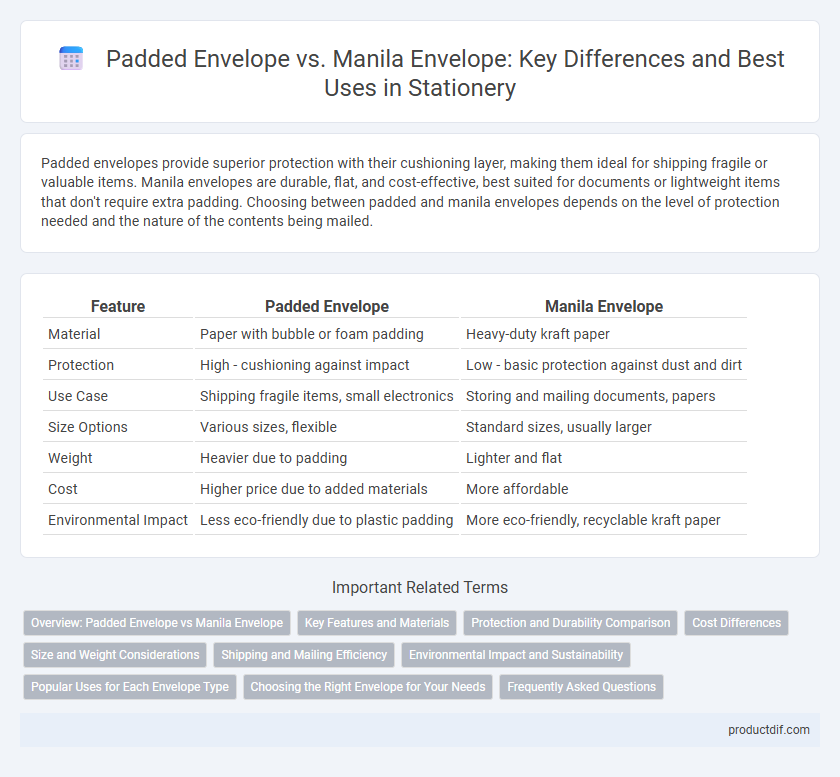Padded envelopes provide superior protection with their cushioning layer, making them ideal for shipping fragile or valuable items. Manila envelopes are durable, flat, and cost-effective, best suited for documents or lightweight items that don't require extra padding. Choosing between padded and manila envelopes depends on the level of protection needed and the nature of the contents being mailed.
Table of Comparison
| Feature | Padded Envelope | Manila Envelope |
|---|---|---|
| Material | Paper with bubble or foam padding | Heavy-duty kraft paper |
| Protection | High - cushioning against impact | Low - basic protection against dust and dirt |
| Use Case | Shipping fragile items, small electronics | Storing and mailing documents, papers |
| Size Options | Various sizes, flexible | Standard sizes, usually larger |
| Weight | Heavier due to padding | Lighter and flat |
| Cost | Higher price due to added materials | More affordable |
| Environmental Impact | Less eco-friendly due to plastic padding | More eco-friendly, recyclable kraft paper |
Overview: Padded Envelope vs Manila Envelope
Padded envelopes provide enhanced protection with a cushioning layer, making them ideal for shipping fragile or delicate items, while Manila envelopes offer a lightweight, economical option primarily used for documents and flat, non-fragile materials. Padded envelopes typically feature bubble wrap or foam lining, ensuring impact resistance and minimizing damage during transit, whereas Manila envelopes are made from sturdy paperboard or kraft paper without internal padding. Both envelope types come in various sizes but differ significantly in their protective qualities and cost-effectiveness depending on the shipping requirements.
Key Features and Materials
Padded envelopes feature a cushioned lining made from bubble wrap or foam, providing enhanced protection for delicate items during shipping. Manila envelopes are crafted from sturdy, heavyweight paper or cardstock, offering durability and a professional appearance for documents and flat items. Both types serve specific purposes based on the need for impact resistance versus rigidity and presentation.
Protection and Durability Comparison
Padded envelopes feature a layer of bubble wrap or foam that provides superior shock absorption and protection against impacts during transit, making them ideal for fragile or delicate items. Manila envelopes are made from sturdy kraft paper offering decent durability and resistance to tearing but lack cushioning, making them less effective for safeguarding breakable contents. For enhanced protection and durability, padded envelopes outperform manila envelopes by combining robust outer material with internal padding to prevent damage.
Cost Differences
Padded envelopes typically cost more than Manila envelopes due to the added protective bubble lining, which increases material and production expenses. Manila envelopes are more economical, made from lightweight kraft paper without cushioning, ideal for documents that do not require extra protection. Businesses often choose Manila envelopes for budget-friendly mailing, while padded envelopes are preferred for shipping fragile items despite the higher price.
Size and Weight Considerations
Padded envelopes typically offer more cushioning for fragile items but are bulkier and heavier compared to manila envelopes of the same size, affecting shipping costs and handling. Manila envelopes are lighter and thinner, making them ideal for documents and flat contents where protection from impact is less critical. Choosing between the two depends on balancing the need for protection with size constraints and weight limits set by shipping carriers.
Shipping and Mailing Efficiency
Padded envelopes provide superior protection for fragile or sensitive items due to their cushioned lining, enhancing shipping safety and reducing damage risk. Manila envelopes, typically made of sturdy kraft paper, offer cost-effective, lightweight options ideal for flat documents, improving mailing efficiency and lowering postage costs. Choosing between padded and Manila envelopes depends on balancing protection needs with weight considerations for optimized shipping performance.
Environmental Impact and Sustainability
Padded envelopes, often made with plastic bubble lining, present greater environmental challenges due to their mixed materials that complicate recycling processes, unlike Manila envelopes which are typically constructed from biodegradable kraft paper. Manila envelopes boast a lower carbon footprint and are more easily compostable, making them a preferred choice for sustainability-conscious businesses. Choosing Manila envelopes supports waste reduction and aligns with eco-friendly office practices focused on minimizing plastic use.
Popular Uses for Each Envelope Type
Padded envelopes are popular for shipping fragile or valuable items such as electronics, jewelry, and small gifts due to their protective cushioning that prevents damage during transit. Manila envelopes are widely used for mailing documents, contracts, and large files because of their sturdy construction and ability to hold multiple sheets without folding. Businesses and individuals prefer padded envelopes for secure packaging and manila envelopes for organized document delivery.
Choosing the Right Envelope for Your Needs
Padded envelopes provide extra cushioning with bubble wrap lining, making them ideal for mailing fragile or valuable items, while manila envelopes offer a sturdy, flat solution for documents and small, non-fragile items. Selecting between padded and manila envelopes depends on the level of protection required and the type of items being shipped. For secure shipping, padded envelopes minimize damage risk, whereas manila envelopes ensure professional presentation for paperwork.
Frequently Asked Questions
Padded envelopes provide superior protection for fragile items with their built-in cushioning, while Manila envelopes are ideal for lightweight documents and offer durability with their thick paper material. Customers often ask about the best envelope choice for mailing electronics or important documents, where padded envelopes are recommended to prevent damage during transit. Common queries also address size options, shipping costs, and environmental impact, with padded envelopes usually costing more but offering better security compared to the economical and recyclable Manila envelopes.
Padded envelope vs Manila envelope Infographic

 productdif.com
productdif.com